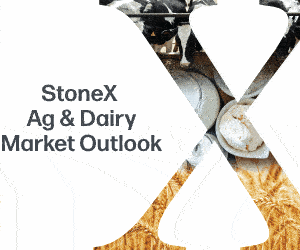 |
|||


|
 |


|
|
Guest Columns
Perspective:
Dairy Markets
Mitigating risk: Tools in your belt
Jon Spainhour
Jon Spainhour is senior commercial advisor at Ever.Ag*, a brokerage firm that specializes in dairy product price risk management. He contributes this column exclusively for Cheese Market News®.
Is there a way to better hedge my cheese risk? It’s a question we get a lot, either directly or indirectly, because properly hedging cheese exposure has been complicated by several variables that could negatively affect even the most carefully planned hedging program. Until the advent of the cash-settled cheese futures (CSC) contract in 2010, cheese hedgers had to use Class III as their main hedging instrument. Class III includes the CSC components, as well as whey and butter. Even for companies willing to overcome this logistical minefield, their accountants certainly fretted over hedge effectiveness. Some companies avoided hedging altogether.
The CSC does present several benefits to the cheese industry, primarily being an effective tool for manufacturers to use when hedging input costs. However, the CSC contract presents challenges in several other use cases. First, it is a weighted average of price and volume of blocks and barrels that is reported in the National Dairy Product Sales Report (NDPSR). Additionally, depending on what the underlying price risk is, there are several inherent basis risks from the underlying commodity to the hedging tool (time lags, the block/barrel spread, and CME spot versus NDPSR price basis). These basis risks can challenge whether the tool (CSC) is effectively removing the price risk.
In 2020, the CME launched the NDPSR block contract. I believe this was an important development and that there is tremendous potential for this contract to continue to grow. Cheese hedgers should take a hard look at the many different ways they can use it as an alternative to using CSC. It actually works.
Let’s start with the obvious. For anyone who needs to specifically hedge blocks, you can avoid the drawbacks of using a block/barrel average and place your hedge directly on blocks. When used in tandem with the CSC contract, barrel hedgers can create a synthetic barrel hedge that serves as a suitable substitute that passes the smell test for the accounting team.
Another risk I have written about in the past is the difference between a cheesemaker’s input cost and output price, which is typically set to either blocks or barrels. Most cheesemakers in the U.S. are exposed to this risk. With the advent of the NDPSR block contract, that risk can be mitigated by using a combination of CSC and NDPSR block contracts.
The OTC markets have long hosted trading in the CME spot cheese monthly average swaps and have played an important role in the cheese hedging ecosystem. This has allowed cheese hedgers to mitigate the hedging risks mentioned above for many years. Some worried that the development of the NDPSR block contract would cannibalize the OTC contracts and the existing CSC contract. As someone who has navigated both the CME and the OTC markets for several years now, I can say that hasn’t happened. In fact, it has improved the liquidity of both the CSC and OTC markets.
In short, the advent of the NDPSR block contract remains another positive development for the cheese hedging community. It provides cheese hedgers the ability to use a tool that matches their risk profile in a more precise manner than the CSC contract. I would encourage anyone who has passed over this contract in the past to contact your broker and discuss how it might be used in your hedging portfolio. This will likely improve your hedge effectiveness and will likely allow your accounting team to sleep a little more soundly.
On July 1, USDA released its recommendation for federal order reform, which included plans to eliminate barrel Cheddar from the cheese portion of the Class III milk price calculation. If this recommendation becomes reality, the CME CSC contract would only reflect NDPSR blocks — essentially eliminating the CME NDPSR block contract.
While this change would certainly change elements of the hedging equation, it would not eliminate the risks associated with manufacturing, selling and buying barrels. For now, we presume the OTC market will likely still provide markets on CME monthly average barrels. I encourage everyone to take the time between now and the potential implementation to understand your new risk profile and seek out the appropriate tools to manage that risk.
CMN
The views expressed by CMN’s guest columnists are their own opinions and do not necessarily reflect those of Cheese Market News®.
*The risk of loss trading commodity futures and options can be substantial. Investors should carefully consider the inherent risks in light of their financial condition. The information contained herein has been obtained from sources to be reliable, however, no independent verification has been made. The information contained herein is strictly the opinion of its author and not necessarily of Ever.Ag and is intended to be a solicitation. Past performance is not indicative of future results. Ever.Ag is an equal opportunity employer.
| CMN article search |

|
© 2025 Cheese Market News • Quarne Publishing, LLC • Legal Information • Online Privacy Policy • Terms and Conditions
Cheese Market News • Business/Advertising Office: P.O. Box 628254 • Middleton, WI 53562 • 608/831-6002
Cheese Market News • Editorial Office: 5315 Wall Street, Suite 100 • Madison, WI 53718 • 608/288-9090